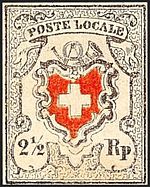Local post and rayon stamps
The local post and rayon stamps are the first stamps issued by the Swiss Federal Post Office . The name refers to the characteristic inscription on the stamp issue. This edition is more rarely referred to as a coat of arms with a post horn based on the motif .
The Ortspost- and rayon brands is the first postal stamps that throughout Switzerland were valid. Before that, however, the cantons of Geneva , Basel and Zurich had already issued stamps , as the Swiss postal service was only founded on January 1, 1849. Until then, the individual cantons were responsible for their own postal service. These canton post stamps were valid at the same time as the local post and rayon stamps until September 30, 1854. They were replaced by the seated Helvetia .
The local post and rayon stamps were issued in the years 1850 to 1852. The first local post stamps were issued in May 1850. On October 1, 1850, Rayon and Rayon II followed. On January 1, 1852, Rayon III was finally issued.
The stamps produced in stone printing show the Swiss cross with a post horn above it . Below that was the value, which indicated the postage of the stamp in cents . However, there are two different types of Rayon III, one with the large 15 Rp. And one with the small 15 Rp. As well as an issue that shows the postage value in centimes . Above it is the inscription Orts-Post , Rayon I , Rayon II or Rayon III . The local postage stamps for the French-speaking areas of Switzerland were also issued with the inscription Poste Locale . The stamps were issued imperforate . The local postage stamps and the rayon stamps were printed on white paper , the local postage, the Poste Locale and the Rayon III in two-color printing, the Rayon I dark blue and light blue and the Rayon II in three-color printing. For Rayon II, for example, the colors yellow, red and black were printed one after the other, with the individual printing stones in different order, similar to the other Rayons in three-color printing.
The inscriptions above the post horn indicate the circumference within which a letter weighing up to half a lot could be transported. The decisive factor here was not only the distance, but also the number of hours the postman had to travel . The following table shows within which postage zone the individual stamps were valid.
| Postage zone | fee | League hours | kilometre |
|---|---|---|---|
| Local post ( Poste Locale ) | 2½ cents | Within the community | Within the community |
| Rayon I | 5 cents | up to 2 leagues | up to 9.6 km |
| Rayon II | 10 cents | up to 10 leagues | up to 48 km |
| Rayon III | 15 cents | up to 40 league hours | up to 192 km |
| Rayon IV | 20 cents | from 40 leagues | from 192 km |
There is no separate issue of stamps for the postage zone Rayon IV. These were also abandoned in 1852 and treated as Rayon III from now on. For letters weighing more than half a lot, an additional 5 cents had to be paid for each additional half lot. It is thanks to these circumstances that the philatelists can find interesting mixed postage .
Furthermore, the first complete edition in Switzerland offers numerous special features, such as differences in characters, colors and paper. It is one of the classic issues of Swiss philately.
